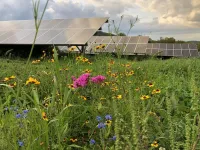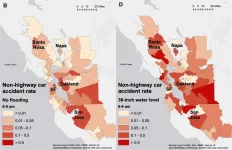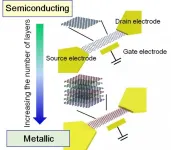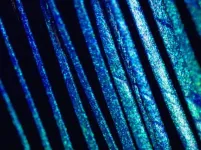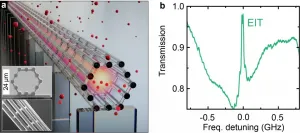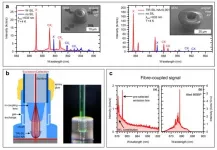(Press-News.org) Annapolis, MD; June 3, 2021--Amid the steady growth of solar energy production in the United States, pollinator conservation at solar installations has become an appealing secondary pursuit, but the long-term success of such efforts remains to be seen. Can the land within a solar farm be made a true resource for pollinating insects? Will solar developers see value in the extra investment to plant and maintain flowering vegetation?
A group of entomologists tackles these questions in a new article published today in the journal Environmental Entomology. They say pairing solar energy with pollinator habitat offers great promise, but scientific evaluation and meaningful standards will be key to making it a true win-win combination.
Already, eight states have enacted legislation to promote pollinator-friendly solar development (Illinois, Maryland, Michigan, Minnesota, Missouri, New York, South Carolina, and Vermont), all of which include scorecards that outline criteria a solar installation must meet to earn a "pollinator-friendly" designation. The details vary, but the basic requirements are similar from state to state, following well-established principles for habitat that will attract and support bees, butterflies, and other pollinating insects.
"If you stick with the principles of native, perennial, flowering vegetation and think about a mixture of species that would flower through the growing season, that's more than half the battle," says Matthew O'Neal, Ph.D., professor of entomology at Iowa State University and co-author on the paper with Adam Dolezal, Ph.D., assistant professor of entomology at the University of Illinois at Urbana-Champaign, and Jacob Torres, a doctoral student in Dolezal's lab at UIUC.
O'Neal and colleagues endorse the scorecard approach, but they say the criteria should be both stringent enough to produce measurable, positive impacts on pollinators but flexible enough to be feasible within the unique conditions of a solar farm.
"You can say, 'How is this different than a hundred other conservation practices?'" Dolezal says. "And the answer is, well, it has some very weird and specific requirements to make it even on the table for solar developers to consider. And that's something we're still learning."
On a typical solar farm, the zones beneath solar panels, immediately adjacent to them, and around the perimeter of the farm each allow for different mixes of plants. Some solar panels, for instance, may stand just 18 inches off the ground, which would rule out tall grasses and non-shade-tolerant plants beneath them.
If the right mix of plants can be found, however, solar developers could stand to gain more than just positive, green public relations for their utilities. Some preliminary research suggests surrounding vegetation can boost efficiency of solar panels, but more in-depth analysis is needed. "We know that plants, through respiration, cool the air around them, and we know that, when solar panels are kept cooler, they are more efficient at producing electricity," says Dolezal. "What has not been demonstrated is, in these real-world, utility-scale facilities, does that actually provide a meaningful benefit that can then be quantified, put into an economic analysis that developers can look at and say, 'We will make X amount more megawatts of energy over what duration.'"
A scorecard for solar-farm pollinator habitat is also just a first step. Many plants recommended for pollinator conservation take time to establish and require attention to weed out unwanted, non-native plants. So, Dolezal, Torres, and O'Neal recommend standards also be paired with periodic evaluations by independent, certified third parties. "These environments are dynamic," O'Neal says. "You want to make sure those plants are established and you meet the goals that you set out at the start."
Other key elements for pollinator conservation at solar farms would include detailed maintenance and cultivation plans, clarity on whether to focus on wild pollinators or managed honey bees, and cooperation with local communities.
"What may be true or what may work well in Iowa and Illinois and Indiana may not work in the Southeast, or it may not work in the coastal mid-Atlantic," says Dolezal. "The realities are going to be different there."
Research has shown that even small patches of native habitat in otherwise cleared or developed areas can provide important resources for conserving plant and animal biodiversity. O'Neal and colleagues note examples of planned solar facilities in some states of several thousands of acres. "If even a fraction of the land allotted to future developments can be planted with effective pollinator habitat, these contributions could be substantial," they write.
As more and more solar energy developments come into shape, researchers will have the opportunity to start measuring just how effective accompanying pollinator habitat may be. Dolezal will be among them, as he works on a project selected for funding by the U.S. Department of Energy's Solar Technologies Office and managed by the University of Illinois Chicago. He'll be helping to evaluate ecological benefits, solar-production performance benefits, and economic impacts of pollinator plantings at six solar facilities.
It is a setting Dolezal says he never envisioned when he began studying entomology and one that speaks to the unique combination of solar energy and pollinator conservation.
"This would not have been a mechanism of habitat implementation I would have expected, for sure," he says. "And I never would have expected to have to go do pollinator sampling while wearing a hard hat."
INFORMATION:
"Can Solar Energy Fuel Pollinator Conservation?" will be published online on June 3, 2021, in Environmental Entomology. Journalists may request advance copies of the article via the contact below or download the published paper after 10 a.m. on June 3 at https://doi.org/10.1093/ee/nvab041.
CONTACT: Joe Rominiecki, jrominiecki@entsoc.org, 301-731-4535 x3009
ABOUT: The Entomological Society of America is the largest organization in the world serving the professional and scientific needs of entomologists and people in related disciplines. Founded in 1889, ESA today has more than 7,000 members affiliated with educational institutions, health agencies, private industry, and government. Headquartered in Annapolis, Maryland, the Society stands ready as a non-partisan scientific and educational resource for all insect-related topics. For more information, visit http://www.entsoc.org.
Environmental Entomology publishes reports on the interaction of insects with the biological, chemical, and physical aspects of their environment. For more information, visit https://academic.oup.com/ee, or visit http://www.insectscience.org to view the full portfolio of ESA journals and publications.
WINSTON-SALEM, N.C. - June 03, 2021 - When people think of microbiome, they typically think about the gut, but there's also a breast microbiome, and the role it plays in breast health and breast cancer isn't thoroughly understood. A microbiome is the collection of microorganisms that live in a particular environment in the body.
In 2018, scientists at Wake Forest School of Medicine, part of Wake Forest Baptist Health, showed that diet can influence the breast microbiome, demonstrating that like the gut microbiome, the breast microbiota can respond to diet.
Now, new research ...
A dash of milk could make all the difference to a healthy heart as new research from the University of South Australia finds that people who regularly consume milk have a lower risk of heart disease.
Conducted in partnership with the University of Reading, the world-first study used a genetic-approach to investigate causal relationships between milk consumption and risk of cardiovascular disease.
Assessing genetic biomarkers among 400,000+ people, the study found that greater milk consumption was associated with lower blood cholesterol, lower blood lipid levels, and a lower risk of heart disease.
Cardiovascular diseases are ...
Almost half of the world's population currently lives in cities and that number is projected to rise significantly in the near future. This rapid urbanization is contributing to increased flood risk due to the growing concentration of people and resources in cities and the clustering of cities along coastlines.
These urban shifts also result in more complex and interconnected systems on which people depend, such as transportation networks. Disruptions to urban traffic networks from flooding or other natural disasters can have serious socioeconomic consequences. In fact, what are defined as indirect impacts from these types of events, such as commute-related ...
Researchers from Osaka University, Toyo University, and Kyushu Institute of Technology clarified the expression mechanism of semiconducting and metallic properties in graphene nanoribbons (GNRs) by analyzing the carrier transport properties in the field effect transistor (FET) with a multilayer GNR channel (Fig. 1).
The research team fabricated multilayer GNRs with precisely controlled numbers of layers via a chemical vapor deposition method using a solid template. "This enabled us to compare the observed carrier transport properties in the FET using a multilayer ...
A recent study by a team of researchers led by Dr Vinod Kumar Saranathan from the Division of Science at Yale-NUS College has discovered a complex, three-dimensional crystal called the single gyroid within feathers of the blue-winged leafbird. Dr Saranathan and his team's breakthrough came from their investigation of the feather colours of leafbirds, an enigmatic group of perching birds endemic to South and Southeast Asia (including Singapore), one species of which has evolved the unique crystals in its plumage.
By comparing the colour-producing nanostructures present in close relatives, the team reported that this species is able to directly synthesise single gyroid ...
BUFFALO, N.Y. - College students who engaged in four or more high-impact practices such as study abroad or internships have a 70% chance of either enrolling in graduate school or finding a full-time job after graduating with a bachelor's degree, finds a new University at Buffalo study.
Each additional high-impact practice increased a student's chance of attaining a bachelor's degree and a full-time job by 17% or enrolling in graduate school by 30%, according to the study. These practices - such as study abroad, internships, undergraduate research, community service, first-year ...
In the rapidly growing field of hybrid quantum photonics, the realization of miniaturized, integrated quantum-optical systems with intense light-matter interaction is of great importance for both fundamental and applied research. In particular, the development of methods for reliably generating, controlling, storing and retrieving quantum states with high fidelity through coherent interaction of light and matter opened up a wide field of applications for quantum information and quantum networks. These include, for example, optical switching, quantum memories, and quantum repeaters.
One promising approach for efficient light-matter interaction is the integration of light-guiding platforms in a near-room-temperature alkali vapor. Several research groups have aimed to ...
Lithium is a vital element in the batteries that power electric vehicles, but soaring lithium demand is expected to exhaust land-based reserves by 2080. KAUST researchers have now developed an economically viable system that can extract high-purity lithium from seawater.
The oceans contain about 5,000 times more lithium than the land but at extremely low concentrations of about 0.2 parts per million (ppm). Larger ions, including sodium, magnesium and potassium, are all present in seawater at much higher concentrations; however, previous research efforts to tease ...
Quantum computing and quantum communication are believed to be the future of information technology. In order to achieve the challenging and long-standing goal to make secure, wide-spread quantum communication networks a reality, high-brightness single-photon sources are indispensable. Single-photon emission from semiconductor quantum dots (QDs) has been shown to be a pure and efficient non-classical light source with a high degree of indistinguishability. However, the total internal reflection (TIR) as a result of the high semiconductor-to-air refractive index contrast severely limits the single-photon extraction efficiency. Another crucial step in the development ...
For decades, researchers have debated whether the buildup of certain electrical activities in the brain indicates that human beings are unable to act out of free will.
Experiments spanning the 1960s and 1980s measured brain signals noninvasively and led many neuroscientists to believe that our brains make decisions before we do--that human actions were initiated by electrical waves that did not reflect free, conscious thought.
However, a new article in Trends in Cognitive Science argues that recent research undermines this case against free will.
"This new perspective on the data turns on its head the way well-known findings have been interpreted," said Adina Roskies, the Helman Family Distinguished Professor and professor of philosophy at ...
